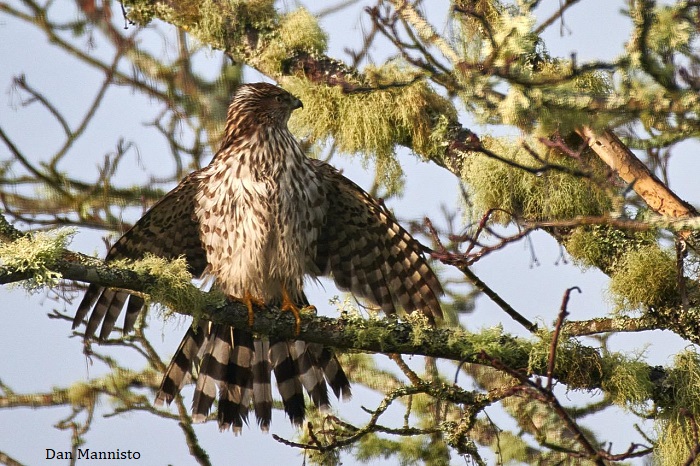Birds and Wildlife
Cooper's Hawk or Sharp-shinned Hawk?
Polly Adcock
December 2020
|

|
Late one afternoon several years ago as my husband and I were sitting on the back porch,
something came across the house like a SPEEDING BULLET and landed with a a SINGLE BOUND
making a POP sound, and before we could focus, it ascended over the fence into the neighbor's yard.
We looked at each other. “What was THAT?!” We went to look and saw a large bird furiously
plucking another bird, perhaps a pigeon.
Since that afternoon we have seen a Cooper's Hawk many times in our neighborhood: perched
high in a tree, on the power line, on the bird feeder and on snow-covered ground with a little bird
trapped under its foot. A few weeks ago one was perched on my backyard fence next to the house,
apparently waiting for the lunch time smorgasbord to show up.
This hawk is similar to the Sharp-shinned hawk but larger, more crow size. Adult birds are
blue-gray above, white barred with rusty below. The immature are brown with blackish streaks above.
The Cooper's has a long tail that is gray and black and ROUNDED at the ends with a wider white band
on the tips, but the Sharpie has a shorter SQUARED tail and more narrow white bands on the tips. As
with most raptors, the female is about one third larger that the male
Both kinds of mature birds have red eyes. Because a male Cooper's (smaller) can be mistaken for a
Sharpie female (larger), even the experts are often fooled! I saw SUPERbird.
The Reader's Digest, Smithsonian and Cornell Lab online all showed that both birds are
permanent residents in our area.
The Cooper's Hawk a native of North America was named in honor of William Cooper of New
York who was the first to collect and identify it.
This accipiter or bird of prey is also known as “the chicken hawk”. In pursuit of prey its flight
becomes powerful, quick and very AGILE; even allowing the bird to thread between tree branches.
Its diet consists of medium size birds such as starlings, doves, pigeons, blue jays, quail, flickers AND
chickens. It will hunt mammals such as squirrels, rabbits and bats. However the smaller Sharpie will
go for smaller birds, including song birds, reptiles and large insects.
According to the Cornell Lab, if a hawk takes up residence near your feeder, take down the
feeder for a few days and the hawk will move on. I can only hope.
|
|
|
|
|
|
|
|